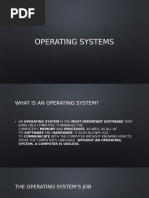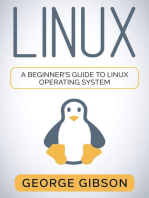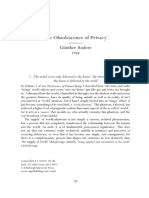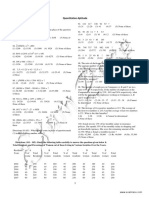What Is An Operating System
Uploaded by
Kasun DharshanaWhat Is An Operating System
Uploaded by
Kasun Dharshana16/02/2014
What is an Operating System?
An operating system is the most important software that runs on a computer. It manages the computer's memory, processes, and all of its software and hardware. It also allows you to communicate with the computer without knowing how to speak the computer's "language." Without an operating system, a computer is useless. The Operating System's Job You've probably heard the phrase boot your computer, but do you know what that means? Booting is the process that occurs when you press the power button to turn your computer on. During this process (which may take a minute or two), the computer does several things:
It runs tests to make sure everything is working correctly. It checks for new hardware. It then starts up the operating system.
Windows 7 startup screen
Once the operating system has started up, it manages all of the software and hardware on the computer. Most of the time, there are many different programs running at the same time, and they all need to access your computer's Central Processing Unit (CPU), memory, and storage. The operating system coordinates all of this to make sure that each program gets what it needs. Without the operating system, the software wouldn't even be able to talk to the hardware, and the computer would be useless.
16/02/2014
Windows 7, after starting up
Types of Operating Systems
Operating systems usually come preloaded on any computer that you buy. Most people use the operating system that comes with their computer, but it is possible to upgrade or even change operating systems. The three most common operating systems for personal computers are Microsoft Windows, Apple Mac OS X, and Linux.
The Windows, OS X, and Linux logos
Modern operating systems use a Graphical User Interface, or GUI (pronounced "gooey"). A GUI lets you use your mouse to click on icons, buttons, and menus, and everything is clearly displayed on the screen using a combination of graphics and text. Each operating system's GUI has a different look and feel, so if you switch to a different operating system it may seem unfamiliar at first. However, modern operating systems are designed to be easy to use, and most of the basic principles are the same.
16/02/2014
The Windows GUI
The OS X GUI Before GUIs, computers had a command-line interface, which meant the user had to type every single command to the computer, and the computer would only display text.
16/02/2014
Microsoft Windows
Microsoft created the Windows operating system in the mid-1980s. Over the years, there have been many different versions of Windows, but the most recent ones are Windows 8 (released in 2012), Windows 7 (2009), and Windows Vista (2007). Windows comes preloaded on most new PCs, which helps to make it the most popular operating system in the world. If you're buying a new computer or upgrading to a newer version of Windows, you can choose from several different editions of Windows, such as Home Premium, Professional, and Ultimate. You may need to do some research to decide which edition is right for you.
Windows 7
16/02/2014
Apple Mac OS X
Mac OS is a line of operating systems created by Apple Inc. It comes preloaded on all new Macintosh computers, or Macs. All of the recent versions are known as Mac OS X (pronounced Mac O-S Ten), and the specific versions include Mavericks (released in 2013), Mountain Lion (2012), Lion (2011), and Snow Leopard (2009). Apple also offers a version called Mac OS X Server, which is designed to be run on servers. According to StatCounter Global Stats, Mac OS X users account for 7.5% of the operating systems market as of January 2013much lower than the percentage of Windows users (more than 90%). One reason for this is that Apple computers tend to be more expensive. However, many people prefer the look and feel of Mac OS X.
Mac OS X Lion
16/02/2014
Linux
Linux (pronounce LINN-ux) is a family of open-source operating systems, which means that they can be modified and distributed by anyone around the world. This is very different from proprietary software like Windows, which can only be modified by the company that owns it (Microsoft). The advantages of Linux are that it is free, and there are many different distributions (or versions) that you can choose from. Each distribution has a different look and feel, and the most popular ones include Ubuntu, Mint, and Fedora. Linux is named after Linus Torvalds, who created the Linux kernel in 1991. The kernel is the computer code that is the central part of an operating system. According to StatCounter Global Stats, Linux users account for less than 1% of the operating systems market as of January 2013. However, most servers run Linux because it's relatively easy to customize.
Ubuntu Linux
16/02/2014
Operating Systems for Mobile Devices
The operating systems that we've been talking about were designed to run on desktop or laptop computers. Mobile devices such as phones, tablet computers, and mp3 players are very different from desktop and laptop computers, so they run operating systems that are designed specifically for mobile devices. Examples of mobile operating systems include Apple iOS, Windows Phone, and Google Android. Operating systems for mobile devices generally aren't as fully featured as those made for desktop or laptop computers, and they aren't able to run all of the same software. However, you can still do a lot of things with them, such as watching movies, browsing the internet, managing your calendar, playing games, and more.
Apple iOS running on an iPad
You might also like
- DEOq Ge TL 0 Yn 3 KED4 BNB 1 Ja P9 VKi U1 Mu 46 B 8 N Ibd 8No ratings yetDEOq Ge TL 0 Yn 3 KED4 BNB 1 Ja P9 VKi U1 Mu 46 B 8 N Ibd 85 pages
- 2-Computer Basics Understanding Operating SystemsNo ratings yet2-Computer Basics Understanding Operating Systems16 pages
- What Is An Operating System?: Types of Operating SystemsNo ratings yetWhat Is An Operating System?: Types of Operating Systems10 pages
- Software - Applications and Operating SystemsNo ratings yetSoftware - Applications and Operating Systems14 pages
- ICT 131 - Lecture 5 - Operating Systems - MU - 2023-1No ratings yetICT 131 - Lecture 5 - Operating Systems - MU - 2023-120 pages
- Universitas Pakuan 2014: English Task System OperatingNo ratings yetUniversitas Pakuan 2014: English Task System Operating4 pages
- Difference of Windows and Linux Operating SystemNo ratings yetDifference of Windows and Linux Operating System13 pages
- Bălțatu - Operating Systems ReferatWordNo ratings yetBălțatu - Operating Systems ReferatWord6 pages
- English 4 IT - Unit 3 Learning About Operating Systems ReadingNo ratings yetEnglish 4 IT - Unit 3 Learning About Operating Systems Reading2 pages
- Musuko Ga Kawaikute Shikataganai Mazoku No Hahaoya Vol.9 Chapter 200 Successor - ManganeloNo ratings yetMusuko Ga Kawaikute Shikataganai Mazoku No Hahaoya Vol.9 Chapter 200 Successor - Manganelo1 page
- Get Principles of Biomedical Engineering Second Edition Sundararajan Madihally free all chapters100% (3)Get Principles of Biomedical Engineering Second Edition Sundararajan Madihally free all chapters45 pages
- Contingency Perspectives of Organizational Strategy - A Critical Review of The Empirical ResearchNo ratings yetContingency Perspectives of Organizational Strategy - A Critical Review of The Empirical Research15 pages
- USA V Kevin Seefried Sentencing Memo by USANo ratings yetUSA V Kevin Seefried Sentencing Memo by USA42 pages
- Practical Guide To Evil Jumpchain UpdatedNo ratings yetPractical Guide To Evil Jumpchain Updated15 pages
- Anders 1958 The Obsolescence of Privacy PDFNo ratings yetAnders 1958 The Obsolescence of Privacy PDF27 pages
- ICT_XI_Year Final(Sample Questions (June-2024)EMNo ratings yetICT_XI_Year Final(Sample Questions (June-2024)EM8 pages
- Syllabus Combined Ad No 8 & 9 Combined-2022No ratings yetSyllabus Combined Ad No 8 & 9 Combined-202239 pages
- (Extended) Roll Me A Deity - by Assassin NPCNo ratings yet(Extended) Roll Me A Deity - by Assassin NPC35 pages
- Quantitative Aptitude Sample Paper 1 PDFNo ratings yetQuantitative Aptitude Sample Paper 1 PDF9 pages
- DEOq Ge TL 0 Yn 3 KED4 BNB 1 Ja P9 VKi U1 Mu 46 B 8 N Ibd 8DEOq Ge TL 0 Yn 3 KED4 BNB 1 Ja P9 VKi U1 Mu 46 B 8 N Ibd 8
- What Is An Operating System?: Types of Operating SystemsWhat Is An Operating System?: Types of Operating Systems
- ICT 131 - Lecture 5 - Operating Systems - MU - 2023-1ICT 131 - Lecture 5 - Operating Systems - MU - 2023-1
- Universitas Pakuan 2014: English Task System OperatingUniversitas Pakuan 2014: English Task System Operating
- English 4 IT - Unit 3 Learning About Operating Systems ReadingEnglish 4 IT - Unit 3 Learning About Operating Systems Reading
- Linux: A Beginner's Guide to Linux Operating SystemFrom EverandLinux: A Beginner's Guide to Linux Operating System
- Musuko Ga Kawaikute Shikataganai Mazoku No Hahaoya Vol.9 Chapter 200 Successor - ManganeloMusuko Ga Kawaikute Shikataganai Mazoku No Hahaoya Vol.9 Chapter 200 Successor - Manganelo
- Get Principles of Biomedical Engineering Second Edition Sundararajan Madihally free all chaptersGet Principles of Biomedical Engineering Second Edition Sundararajan Madihally free all chapters
- Contingency Perspectives of Organizational Strategy - A Critical Review of The Empirical ResearchContingency Perspectives of Organizational Strategy - A Critical Review of The Empirical Research

























































































